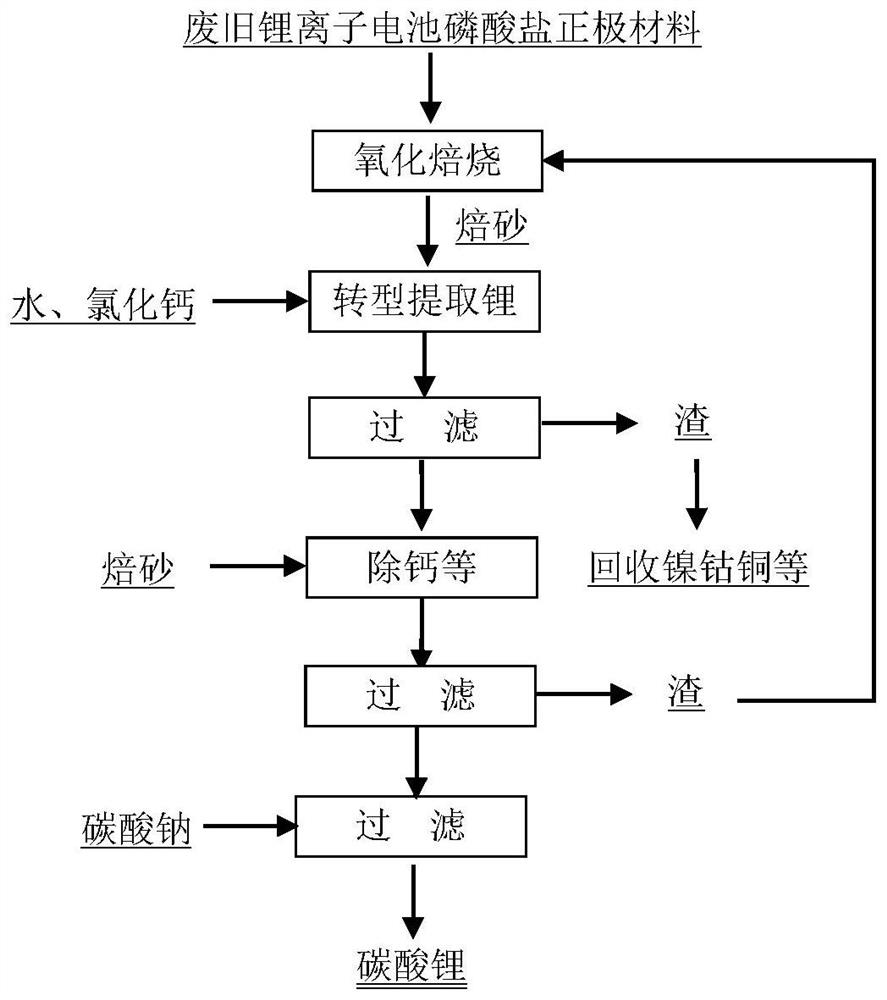Method for selectively extracting lithium from waste lithium-ion battery materials
A lithium-ion battery and lithium extraction technology, applied in secondary batteries, battery recycling, circuits, etc., can solve problems affecting the purity of lithium salt products, low lithium ion concentration, high-salt wastewater environment, etc., to avoid disposal and environmental problems , increase the concentration of lithium, and simplify the recovery process
- Summary
- Abstract
- Description
- Claims
- Application Information
AI Technical Summary
Problems solved by technology
Method used
Image
Examples
Embodiment 1
[0035] Oxidize and roast the lithium iron phosphate positive electrode material obtained from dismantling, crushing and screening waste lithium-ion batteries at 500-1000°C to obtain calcined sand; add calcined sand to the dissolution mill to adjust the slurry with water, and add an appropriate amount of chloride Calcium is transformed, the amount of calcium chloride added is 0.5 to 1 times the molar number of lithium in the calcine, the amount of water added is 1 to 4 times the mass of the calcine, and the transformation temperature is 20 to 100°C. The slurry is subjected to solid-liquid separation to obtain a lithium-containing solution.
Embodiment 2
[0037] The lithium iron phosphate positive electrode material obtained from dismantling, crushing and screening of waste lithium-ion batteries is oxidized and roasted at 850°C to obtain calcined sand; the calcined sand is added to the dissolution mill, and water and an appropriate amount of calcium chloride are added for transformation. The amount of calcium chloride is added according to 0.6 times the molar number of lithium in the calcine, the amount of water added is added according to 2 times the mass of the calcine, the transformation temperature is 25°C, and the transformed slurry is subjected to solid-liquid separation to obtain lithium-containing solution.
Embodiment 3
[0039] The lithium iron phosphate cathode material obtained from the dismantling, crushing and screening of waste lithium-ion batteries is oxidized and roasted at 800°C to obtain calcined sand; the calcined sand is added to the dissolution mill, and an appropriate amount of water and lime are added for transformation. The amount of addition is 0.6 times the number of moles of lithium in the calcine, the amount of water added is 2 times the mass of the calcine, the transformation temperature is 25°C, and the transformed slurry is subjected to solid-liquid separation to obtain lithium-containing solution and transformation slag . Add an appropriate amount of lithium phosphate to the obtained lithium-containing solution, stir and react for a period of time, then filter to obtain the lithium solution and purification residue, and return the purification residue to oxidation roasting, or return the purification residue to mix with calcine for salt leaching.
PUM
 Login to View More
Login to View More Abstract
Description
Claims
Application Information
 Login to View More
Login to View More - R&D
- Intellectual Property
- Life Sciences
- Materials
- Tech Scout
- Unparalleled Data Quality
- Higher Quality Content
- 60% Fewer Hallucinations
Browse by: Latest US Patents, China's latest patents, Technical Efficacy Thesaurus, Application Domain, Technology Topic, Popular Technical Reports.
© 2025 PatSnap. All rights reserved.Legal|Privacy policy|Modern Slavery Act Transparency Statement|Sitemap|About US| Contact US: help@patsnap.com

